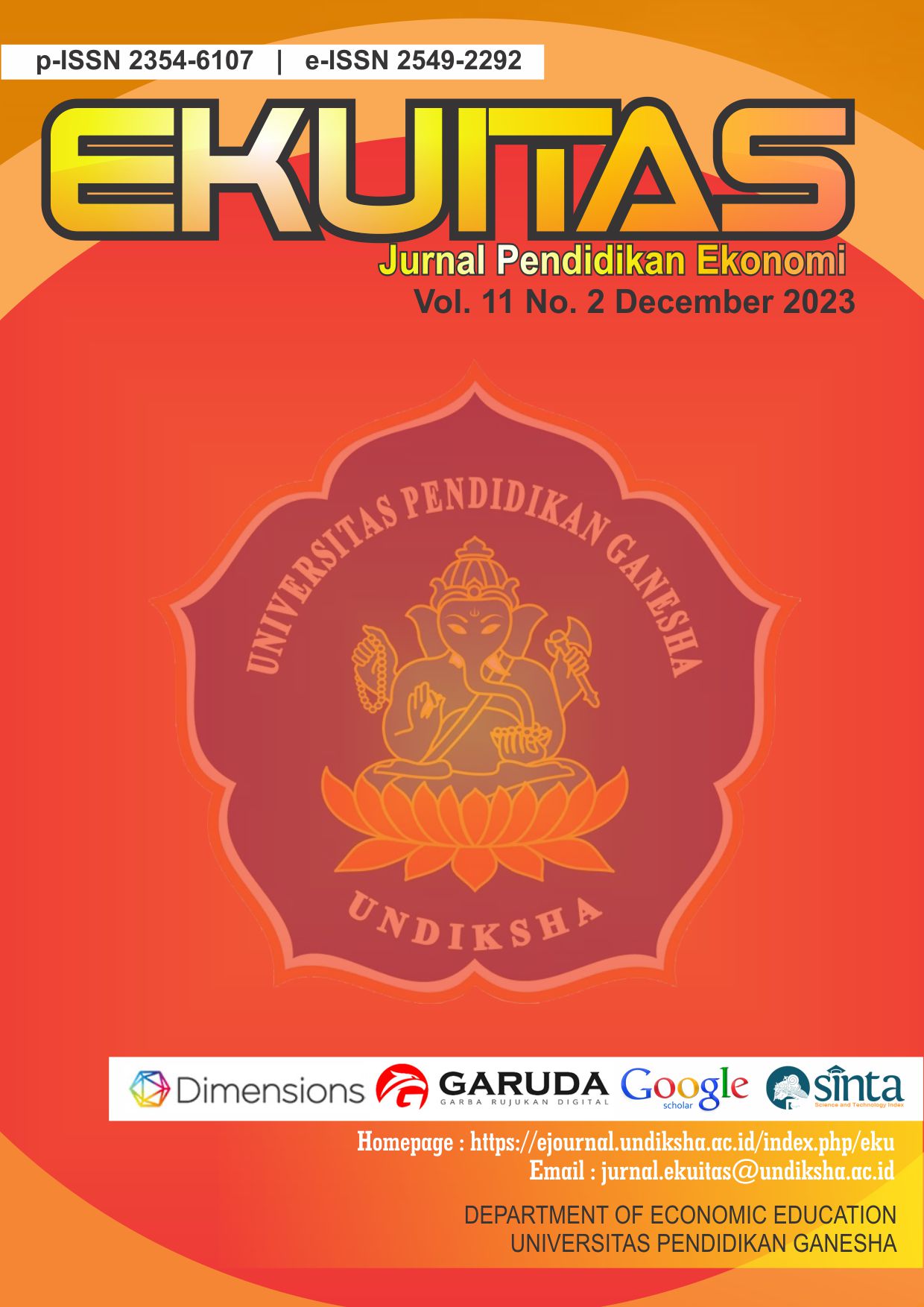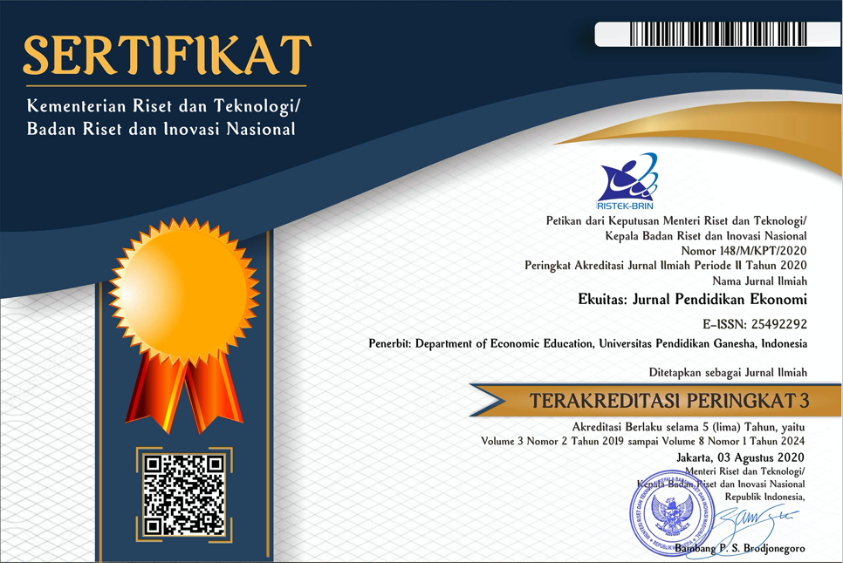Pengembangan Keunggulan Bersaing UMKM Sektor Fashion di Kota Denpasar Berbasis Digitalisasi dan Kapabilitas Inovasi: Peran Mediasi Organizational Agility
DOI:
https://doi.org/10.23887/ekuitas.v11i2.69035Keywords:
Digitalization, fashion, innovation capability, MSMEs, organizational agilityAbstract
MSMEs in the local fashion sector must be able to have a competitive advantage compared to competitors. The maintenance of a competitive edge is important for micro, small, and medium enterprises (MSMEs) operating within the fashion sector, as it enables them to surpass their competitors through the production of higher or more cost-effective products and services. This, in turn, leads to heightened sales performance. The integration of innovation, digitization, and organizational agility capabilities is crucial for the development of this model in order to attain a competitive edge. Historically, the integration of digitalization, innovation capabilities, and organizational agility within the competitive advantage framework for MSMEs was infrequently implemented. The purpose of this study is to test and explain the development of competitive advantage for MSMEs in the fashion sector in Denpasar City based on digitalization and innovation capabilities mediated by organizational agility. Based on the results of the study, it was found that innovation and digitalization capabilities have a positive and significant effect on organizational agility and competitive advantage. The implications of this research are that in order to have a competitive advantage, MSMEs in the fashion sector in Denpasar City must have good organizational agility, innovation capability, and digitalization.
References
Anwar, M., Rehman, A. U., & Shah, S. Z. A. (2018). Networking and new venture’s performance: mediating role of competitive advantage. International Journal of Emerging Markets, 13(5), 998–1025.
Arsawan, I., Koval, V., Suhartanto, D., Harbar, Z., & Maslennikov, Y. (2022). Employee-driven innovation capability: the role of knowledge, creativity, and time sufficiency.
Ashrafi, A., Ravasan, A. Z., Trkman, P., & Afshari, S. (2019). The role of business analytics capabilities in bolstering firms’ agility and performance. International Journal of Information Management, 47, 1–15.
Battour, M., Barahma, M., & Al-Awlaqi, M. (2021). The relationship between HRM strategies and sustainable competitive advantage: testing the mediating role of strategic agility. Sustainability, 13(9), 5315.
Buer, S.-V., Semini, M., Strandhagen, J. O., & Sgarbossa, F. (2021). The complementary effect of lean manufacturing and digitalisation on operational performance. International Journal of Production Research, 59(7), 1976–1992.
Dinas Koperasi dan UMKM Kota Denpasar. (2022). Rekapitulasi Data UMKM Per Sektor Usaha. https://pusatdata.denpasarkota.go.id/?page=Data-Detail&language=id&domian=ppid.denpasarkota.go.id&data_id=1665021040
Ehtesham Rasi, R., Abbasi, R., & Hatami, D. (2019). The Effect of Supply Chain Agility Based on Supplier Innovation and Environmental Uncertainty. International Journal of Supply and Operations Management, 6(2), 94–109.
El Nsour, J. A. (2021). “Investigating the impact of organizational agility on the competitive advantage.” Journal of Governance and Regulation, 10(1).
Elazhary, M., Popovič, A., Henrique de Souza Bermejo, P., & Oliveira, T. (2023). How information technology governance influences organizational agility: the role of market turbulence. Information Systems Management, 40(2), 148–168.
Ferreira, J., Cardim, S., & Branco, F. (2018). Dynamic capabilities, marketing and innovation capabilities and their impact on competitive advantage and firm performance. 2018 13th Iberian Conference on Information Systems and Technologies
(CISTI), 1–7.
Ferreira, J., Coelho, A., & Moutinho, L. (2020). Dynamic capabilities, creativity and innovation capability and their impact on competitive advantage and firm performance: The moderating role of entrepreneurial orientation. Technovation, 92, 102061.
Giacosa, E., Culasso, F., & Crocco, E. (2022). Customer agility in the modern automotive sector: how lead management shapes agile digital companies. Technological Forecasting and Social Change, 175, 121362.
Hanaysha, J. R., Al-Shaikh, M. E., Joghee, S., & Alzoubi, H. M. (2022). Impact of innovation capabilities on business sustainability in small and medium enterprises. FIIB Business Review, 11(1), 67–78.
Hwang, W.-S., Choi, H., & Shin, J. (2020). A mediating role of innovation capability between entrepreneurial competencies and competitive advantage. Technology Analysis & Strategic Management, 32(1), 1–14.
Khorsheed, R. K., Abdulla, D. F., Othman, B. A., Mohammed, H. O., & Sadq, Z. M. (2020). The Role of Services Marketing Mix 7P’s on Achieving Competitive Advantages (The Case of Paitaxt Technical Institute in Kurdistan Region of Iraq). TEST Engineering and Management, 83, 15947–15971.
Knudsen, E. S., Lien, L. B., Timmermans, B., Belik, I., & Pandey, S. (2021). Stability in turbulent times? The effect of digitalization on the sustainability of competitive advantage. Journal of Business Research, 128, 360–369.
Kompas. (2023). “Thrifting” dinilai merusak pasar UMKM.
https://money.kompas.com/read/2023/03/21/200230426/thrifting-dinilai-merusak-pasar-umkm.
Lee, Y. Y., & Falahat, M. (2019). The impact of digitalization and resources on gaining competitive advantage in international markets: Mediating role of marketing, innovation and learning capabilities. Technology Innovation Management Review, 9(11).
Liu, C.-H., Chang, A. Y.-P., & Fang, Y.-P. (2020). Network activities as critical sources of creating capability and competitive advantage: The mediating role of innovation capability and human capital. Management Decision, 58(3), 544–568.
Liu, H.-M., & Yang, H.-F. (2020). Network resource meets organizational agility: Creating an idiosyncratic competitive advantage for SMEs. Management Decision, 58(1), 58–75.
Lo, M. F., & Tian, F. (2020). Enhancing competitive advantage in Hong Kong higher education: Linking knowledge sharing, absorptive capacity and innovation capability. Higher Education Quarterly, 74(4), 426–441.
Lovely, L., Ottemoesoe, R. S. D., & Devie, D. (2021). Information Technology Capabilities, Organizational Agility, and Competitive Advantage: A Study of Micro, Small, and Medium Enterprises in Indonesia. Petra International Journal of Business Studies, 4(2), 131–141.
Mamonto, F. W., Tumbuan, W. J. F. A., & Rogi, M. H. (2021). Analisis faktor-faktor bauran pemasaran (4p) terhadap keputusan pembelian pada rumah makan podomoro poigar di era normal baru. Jurnal EMBA: Jurnal Riset Ekonomi, Manajemen, Bisnis Dan Akuntansi, 9(2).
Miceli, A., Hagen, B., Riccardi, M. P., Sotti, F., & Settembre-Blundo, D. (2021). Thriving, not just surviving in changing times: How sustainability, agility and digitalization intertwine with organizational resilience. Sustainability, 13(4), 2052.
Mohammad, A. S. (2022). Impact of strategic agility on creating competitive advantage: evidence from Jordanian insurance companies. International Journal of Business Innovation and Research, 28(1), 101–118.
P. Kotter, J. (2014). Seizing opportunities and dodging threats with a dual operating system. Strategy & Leadership, 42(6), 10–12.
Pelletier, C., L’Écuyer, F., & Raymond, L. (2023). Digital Transformation Capabilities in Manufacturing SMEs: Gaining Agility through IT Capability Configurations.
Puspita, L. E., Christiananta, B., & Ellitan, L. (2020). The effect of strategic orientation, supply chain capability, innovation capability on competitive advantage and performance of furniture retails. International Journal of Scientific & Technology Research, 9(03), 4521–4529.
Qosasi, A., Permana, E., Muftiadi, A., Purnomo, M., & Maulina, E. (2019). Building SMEs’ competitive advantage and the organizational agility of apparel retailers in Indonesia: The role of ICT as an initial trigger. Gadjah Mada International Journal of Business, 21(1), 69–90.
Rozak, H. A., Adhiatma, A., Fachrunnisa, O., & Rahayu, T. (2021). Social media engagement, organizational agility and digitalization strategic plan to improve SMEs’ performance. IEEE Transactions on Engineering Management.
Sadq, Z. M., Othman, B., & Khorsheed, R. K. (2019). The impact of tourism marketing in enhancing competitive capabilities. African Journal of Hospitality, Tourism and Leisure, 8(5), 1–11.
Salimi, M., & Nazarian, A. (2022). The effect of organisational agility as mediator in the relationship between knowledge management, and competitive advantage and innovation in sport organisations. International Journal of Knowledge Management Studies, 13(3), 231–256.
Sancoyo, N., Putriana, L., & Wicaksana, S. A. (2023). Analisa Pengaruh Organizational Structure, Dynamic Capabilities dan Corporate Culture terhadap Organization Agility Tim Produk BRImo dalam rangka terciptanya Sustainable Competitive Advantages PT. Bank Rakyat Indonesia (Persero), Tbk. Journal of Economics and Business UBS, 12(3), 1754–1771.
Saputra, N., Sasanti, N., Alamsjah, F., & Sadeli, F. (2022). Strategic role of digital capability on business agility during COVID-19 era. Procedia Computer Science, 197, 326–335.
Setiawan, A., Yuliana, O. Y., & Deview. (2022). It Capability’s Impact Towards Competitive Advantage Through Business Process Agility On Indonesia’s Accounting Firms During Pandemic. Jurnal Akuntansi Dan Bisnis, 22(1), 94–106.
Shehadeh, M., Almohtaseb, A., Aldehayyat, J., & Abu-AlSondos, I. A. (2023). Digital Transformation and Competitive Advantage in the Service Sector: A Moderated-Mediation Model. Sustainability, 15(3), 2077.
Sulistyo, H., & Ayuni, S. (2020). Competitive advantages of SMEs: The roles of innovation capability, entrepreneurial orientation, and social capital. Contaduría y Administración, 65(1).
Udriyah, U., Tham, J., & Azam, S. (2019). The effects of market orientation and innovation on competitive advantage and business performance of textile SMEs. Management Science Letters, 9(9), 1419–1428.
Wanasida, A. S., Bernarto, I., Sudibjo, N., & Purwanto, A. (2021). The role of business capabilities in supporting organization agility and performance during the COVID-19 pandemic: An empirical study in Indonesia. The Journal of Asian Finance, Economics and Business, 8(5), 897–911.
Wijaya, N., & Rahmayanti, P. (2023). The role of innovation capability in mediation of COVID-19 risk perception and entrepreneurship orientation to business performance. Uncertain Supply Chain Management, 11(1), 227–236.
Wu, K.-J., Tseng, M.-L., Chiu, A. S. F., & Lim, M. K. (2017). Achieving competitive advantage through supply chain agility under uncertainty: A novel multi-criteria decision-making structure. International Journal of Production Economics, 190, 96–107.
Xue, L.-L., Shen, C.-C., & Lin, C.-N. (2023). Effects of internet technology on the innovation performance of small-scale travel agencies: Organizational learning innovation and competitive advantage as mediators. Journal of the Knowledge Economy, 14(2), 1830–1855.
Yawised, K., & Apasrawirote, D. (2022). Exploring Determinants Influencing Digital Marketing Innovative Capability in SMEs. วารสาร เศรษฐศาสตร์ และ กลยุทธ์ การ จัดการ (Journal of Economics and Management Strategy), 9(2), 121–140.
Yusuf, M., Satia, H., Bernardianto, R., Nurhasanah, N., Irwani, I., & Setyoko, P. (2023). Exploring the role of digital leadership and digital transformation on the performance of the public sector organizations. International Journal of Data and Network Science, 7(4), 1983–1990.
Yusuf, M., Surya, B., Menne, F., Ruslan, M., Suriani, S., & Iskandar, I. (2022). Business Agility and Competitive Advantage of SMEs in Makassar City, Indonesia. Sustainability, 15(1), 627.
Zaini, A., Hadiwidjojo, D., Rohman, F., & Maskie, G. (2014). Effect of competitive advantage as a mediator variable of entrepreneurship orientation to marketing performance. Journal of Business and Management, 16(5), 5–10.
Downloads
Published
How to Cite
Issue
Section
License

This work is licensed under a Creative Commons Attribution-ShareAlike 4.0 International License.








